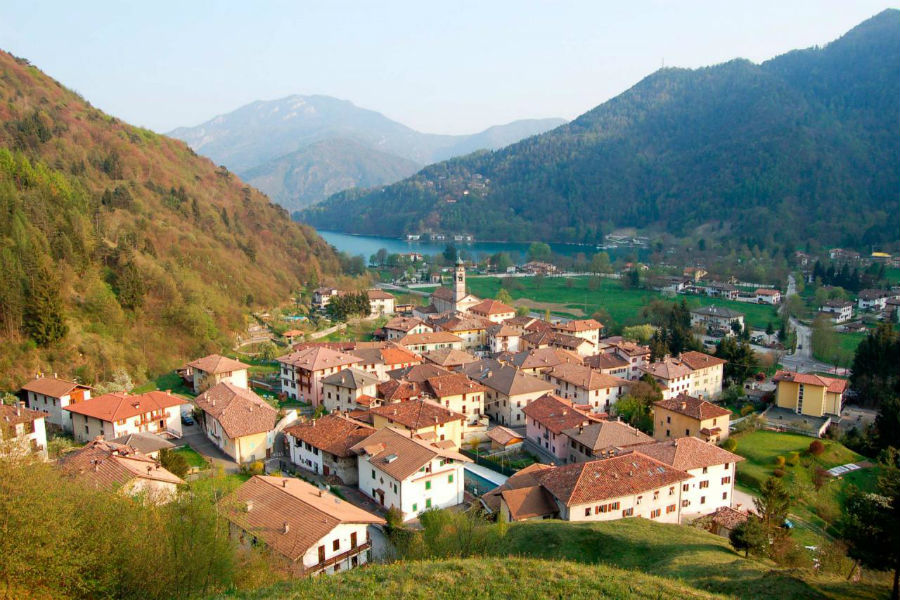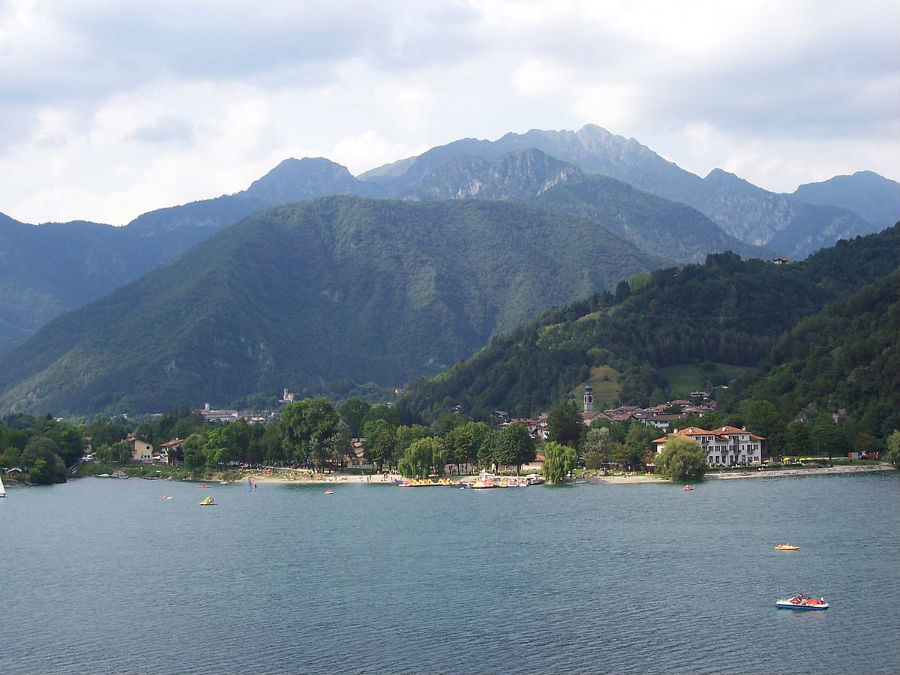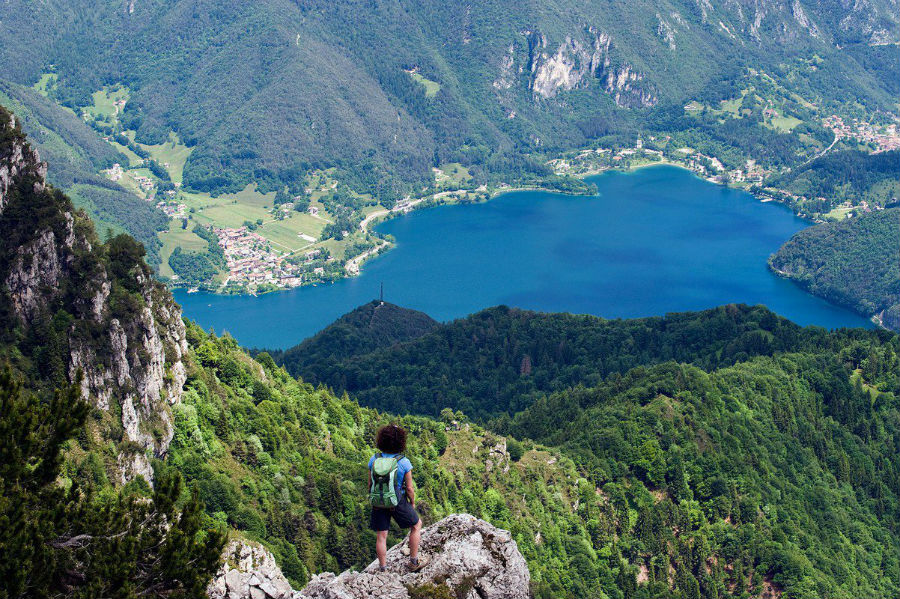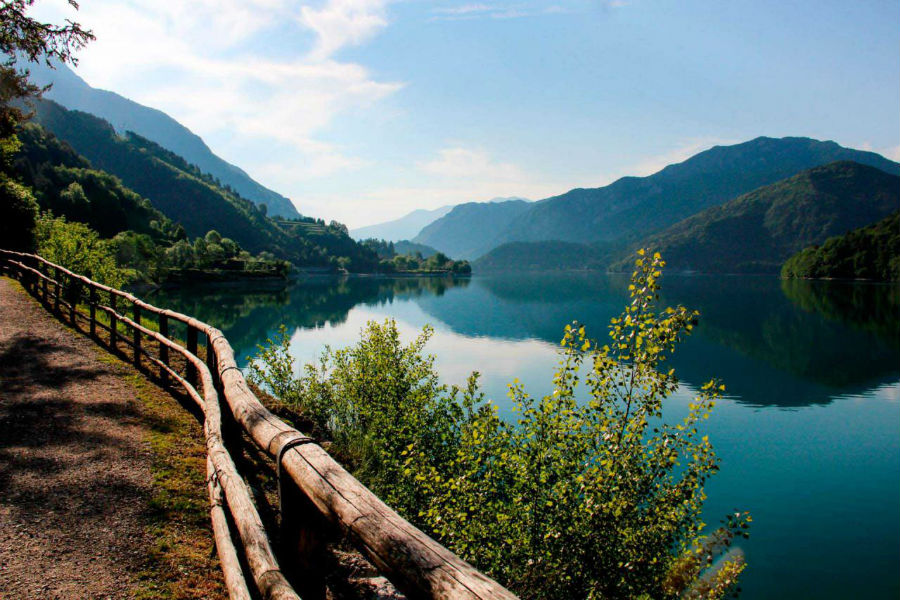Pieve di Ledro
- Village in the mountain
- Village on a lake
- Village with park
- Orange Flag Countries
About the village
The Lago di Ledro is located in a valley suspended that joins the Valle del Chiese valley with the Lake of Garda. When the lake is found under the Austro-Hungarian Empire, the territory of the valley in May 1915 underwent the evacuation of the population which was transferred in some camps located in Bohemia/Moravia (Czech Republic) and Austria. The valley became war zone with south the italian lines dilated until the slopes of the chain of mountains in the north (Monte Vies, Cocca, Coast of Salò, San Giovanni) and comprising all the inhabited centers; directly in contact with the Italian one, to the north, the Austrian line perched on the ridges in cliff of Monte Cadria, Tomeabrù, Parì, Cima d'Oro, Valdes, Rocchetta, Cima Capi; behind this, in the hamlet of fields (Riva del Garda), the strong Tombio for further strengthening of trinceramenti at high altitudes, between 1600 and 2000 meters.
You can still visit most of the line Austro-Hungarian and the connection trenches since dug in the rock at considerable depth, vertical and horizontal, all along the northern slope, from west to east, starting from the fort of Lardaro up to Riva del Garda. The first italian lines assault, precisely because of their position close to the first Austrian, have almost disappeared except some dug in the rock and can be visited to Tiarno di Sopra and below, Bezzecca, near Cima d'Oro and San Giovanni. The third italian line, to the south, extended from Monte Nodic in Pergasina fraction of Riva del Garda running along the top Fortini, monte Carone, Passo Nota, Tremalzo and descended up to Storo; this is still today well visible and workable with mountain-bike and off road (Only authorized); also visible are some Italian fortification in concrete in the plain of Pur and at the entrance of the valle di Concei. During the almost 4 years of conflict in the Valley do not had clashes between large units owing to the small space and the morphology of the mountain lines particularly suited to the defense. At the beginning of the war the italian departments progressed until contact with the Austrian line carefully prepared in the crest from a couple of years and provided of minefields and barbed wire; heavy fighting took place at San Giovanni and the spur, near Cima d'Oro at an altitude of 1336 m and to the coast of Salò; in Valle di Concei were frequent clashes between patrols of explorers and incursori of both armies as well as considerable the bombing of the Italian artillery against the fortifications of high altitude.
At the end of 1918, with the collapse of the front Austro-hungarian, each position was abandoned and subsequently the numerous local recuperanti of valuable materials (iron, copper, gunpowder, ammunition divelsero) all armoured by the domes, from the ports and the lights. Unfortunately the Austrian artillery, by the forts of Riva and fields, to disturbance of italian line, caused the destruction and the fire of all the small towns of Valle di Ledro whose reconstruction was the work by the local population repatriated in 1919 and supported by the military engineers Italian with construction materials, means of transport and logistical support which camp kitchens, provisioning, accommodation and ended in 1924.
At a side of the lake were found the finds of a civilization palafitticola of the Bronze Age, which make the lake an archaeological site and its museum of global significance. On the shore of the lake was rebuilt a village on stilts similar to that existing in the antiquity.
The Lake Ampola because of its particular natural environment is a protected lake. The visitor can find an environment rich in particular vegetal and animal species; a catwalk allows you to go through the wet meadow, approach the Canneto and then the lake. During the summer months is open the Visitors Center of the lake Ampola which organizes guided visits and workshops for children. The lake and the area surrounding wet constitute a peculiar ecosystem that hosts a flora and a fauna specific.
The Valle di Ledro is rich in traditions and local holidays. Among the most important are the Fair of San Michele, in September. The annual summer race of cars in the wood during the festival of Locca. The race of the boats of cardboard on the lake. The dip of the Blackbird in January. The triathlon played in all its categories around the lake.
Village of Pieve di Ledro
Municipality of Ledro
Province of Trento
Trentino Alto Adige Region
Population: 5.323 (623 in the village)
Altitude centre: 660 m s.l.m.
Unesco Site: Prehistoric Pile Dwellings around the alpine arc
the Municipality is part of:
Unesco World Heritage Sites
Comunità Montana Alto Garda e Ledro
Acknowledgments
Orange Flag - Italian Touring Club
Protected Natural Areas:
Biotope Lake Ampola
Municipality
Via Vittoria 5 - Tel. +39 0464 592711
6.11 Kilometers from Pieve di Ledro
7.28 Kilometers from Pieve di Ledro
8.35 Kilometers from Pieve di Ledro
8.51 Kilometers from Pieve di Ledro
46.89 Kilometers from Pieve di Ledro
25.54 Kilometers from Pieve di Ledro
47.74 Kilometers from Pieve di Ledro
57.89 Kilometers from Pieve di Ledro
71.52 Kilometers from Pieve di Ledro
25.68 Kilometers from Pieve di Ledro
BY CAR
- Highway A22: exit Rovereto Sud - SS240 towards Riva del Garda from which you continue to Valle di Ledro
- From Milan: Take the A4 highway and exit at Brescia Est - follow signs for Madonna di Campiglio / Val Sabbia - in Storo continue for Valle di Ledro
ON THE TRAIN
- Rovereto station
BY PLANE
- Verona airport
The Battle of Pieve di Ledro was an episode of the third war of Italian independence and was fought on 18 July 1866, from the afternoon to late evening, between seven companies of 2º regiment Italian volunteers of lieutenant colonel Peter Spinazzi belonging to the body Italian volunteers of Giuseppe Garibaldi and the Austrians of half the brigade of greater Philipp Graf Grunne of the 8ª Division of General Von Kuhn. Won by Garibaldi after a furious combat, forced the Austrians to take refuge in the mountains surrounding the Valle di Ledro and was the prelude to the most famous battle of Bezzecca of 21 July.
Garibaldi, during the course of operation of the Siege of Fort d'Ampola, constantly showed signs of anxiety about the fate of 2º regiment Italian volunteers who, despite his orders, was pushed unwisely too far toward the east on monte note, almost in the mouth to the Austrians. In fact these, according to the general, "gathered in the Valley of Conzei six thousand of his best soldiers, descending along the valley toward Bezzecca with the intention to separate from us the detachments of 2º regiment and cut them into pieces".
The Colonel Peter Spinazzi came on monte note, coming from Vesio of Tremosine, with its seven companies strong about 1,400 men, on the morning of 18 July and immediately realized that the Monte could serve as the basis of military operations since lent itself to both a valid defense is the offensive. From Monte is in fact dominated the Valle di Ledro, that of Bondo, San Michele, Vesio also you could check strategically all the moves any of the enemy on Monte Is, Giumella, Gold and the postal road which led to Riva del Garda.
The Spinazzi after a consultation between officers, in which the greater Numa Palazzini expounded to the approval his plan of attack, decided recklessly to descend into the valley below and assaltare with two columns of Garibaldi the Austrians concentrated around the village of Pieve di Ledro. They, in everything about 1,600 men, belonged to half the brigade of greater Philipp Graf Grunne and was three strong companies of Kaiserjäger, one of tiragliatori, two volunteers and a battery from mountain.
The events that followed during the fight, were then collected in detail in a report that the colonel sent, the next day at Garibaldi and the general Giuseppe Avezzana. This report, also published by the major newspapers of those times, according to the captain Osvaldo Bussi who participated to the clash with its 10ª company, deserved every faith since it had been drawn up by the greater Luigi Castellazzo on the basis of the direct reports of more Numa Palazzini and Amos Ocari that commanded the two columns of assault, as well as from the collection of the information received from the wounded, by depositions made by prisoners of war and by the citizens of Pieve di Ledro and Bezzecca.
During the night the greater Philipp Graf Grunne, believing that the forces of Colonel Spinazzi were numerically superior to his, decided to retire to fields of Riva del Garda leaving only two airlines on the mouth of Trat and a department on Monte Parì, sguarnendo and in this way the Valle di Ledro.
Also the Spinazzi falsely informed of the imminent arrival of strong Austrian reinforcements from Riva del Garda is testified on Monte Note waiting for the support of six companies of 10º regiment from Gargnano that there will come the 20, while between his men grew increasingly impatient for the execution of orders absurd that will lead the next day when, exposed for hours upstream note to a furious storm, forsook the place without the consent of the officers riparandosi to Vesio of Tremosine.
The Wounded Italians and Austrians were provisionally placed, as recalled by the engineer Silvio Martinelli of Pieve di Ledro, "in two rooms of the house of the forest which was used as a hospital, but such use was used also the house of Geneva Biondi" and cared in addition by Dr Giuliano Venturini even by specialists of Garibaldi, the greater, doctor of the regiment, Carlo Regnoli, Lieutenant doctor Carlo Billi and Lieutenant physician Giovanni Battista Bardelli. These last three, to war, will be awarded for the excellent behavior on the battlefield of an award for Military Valor: the first two with the honorable mention, the last with the most prestigious Silver Medal for Military Valor.
The Regnoli was honored "for the zealous and intelligent worked to the injured. Attacked to the provisional hospital of Pieve di Ledro from an enemy detachment, succeeded in enforcing the wounded and take leave with other health care to heal them. Went later on the field of Bezzecca and made still there reported services", the Billi for having assisted "The doctor of the regiment during the day", and finally the Bardelli "because the day 18 with courageous philanthropy never left his injured by refusing to let them even though it had threatened to fall stud of the Austrians".
Sleep, eat, buy...
9.72 Kilometers from Pieve di Ledro
90.23 Kilometers from Pieve di Ledro
71.64 Kilometers from Pieve di Ledro
90.63 Kilometers from Pieve di Ledro
90.57 Kilometers from Pieve di Ledro
24.19 Kilometers from Pieve di Ledro
90.80 Kilometers from Pieve di Ledro
81.30 Kilometers from Pieve di Ledro
71.61 Kilometers from Pieve di Ledro
90.47 Kilometers from Pieve di Ledro
70.39 Kilometers from Pieve di Ledro
90.42 Kilometers from Pieve di Ledro
49.47 Kilometers from Pieve di Ledro
87.92 Kilometers from Pieve di Ledro
72.39 Kilometers from Pieve di Ledro
71.81 Kilometers from Pieve di Ledro
36.51 Kilometers from Pieve di Ledro













